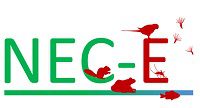The NEC-E partners work together to model the distribution and population dynamics of (invasive) alien species. Theoretical models are combined with data from the field and experiments to determine where the alien species occur, what their lifecycles look like, and how new areas are colonised. The results of these modelling studies are extremely relevant to the risk assessment and management of alien species.
Example publications
Jongejans, E., et al., 2008. Dispersal, demography and spatial population models for conservation and control management. Perspectives in Plant Ecology, Evolution and Systematics 9:153-170. [Link]
Collas, F.P.L., et al., 2017. Detachment rates of dreissenid mussels after boat hull mediated overland dispersal. Hydrobiologia, in press. [Link]
Jongejans, E., et al., 2015. A unifying gravity framework for dispersal. Theoretical Ecology 8:207-223. [Link]
Van Kleef, H. & E. Jongejans, 2014. Identifying drivers of pumpkinseed invasiveness using population models. Aquatic Invasions 9 (3): 315–326. [Link]
Contact person
Eelke Jongejans, Radboud Universiteit
e.jongejans(at)science.ru.nl
